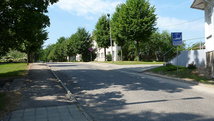Border: Estonia-Latvia
Date(s) of establishment: 1920 (current demarcation in 1991)Length of border: 339 km
Regions concerned: Estonia - Counties of Pärnu, Viljandi, Valga, Võru; Latvia - Limbaži, Valmiera, Valka, Alūksne
European programme(s):
- "Estonia - Latvia" operational programme:
The programme on the Inforegio website - "Central Baltic" operational programme:
Website of the programme
The programme on the Inforegio website
This border, 339km in length, begins in the east at the tripoint between the towns of Misso (Estonia), Pededze (Latvia) and Palkino (Russia). The border runs mostly from east to west. It crosses the town of Valga-Valka and ends at the coast by the Baltic Sea between the villages of Ainaži (Latvia) and Ikla (Estonia).
HistorY
Territory of the former-USSR, Latvia gained independence in 1918, two years before neighbouring Estonia. In 1920, when Estonia gained independence in turn, the border between the two countries was established. The position of the border was recognised by the representatives of the two countries, based upon the ethnicity of the inhabitant populations.
In 1940, the two countries were placed under military occupation and annexed by the USSR, resulting in the disappearance of the border. During this period, the USSR appropriated the towns of Pechory and Abrene (Latvia). Because of this, when the two countries regained their independence in 1991, the re-established border was 32km shorter.
Cross-border cooperation
The Baltic States have a very strong and unique identity. Cross-border cooperation and the Interreg programme are implemented in the context of this identity’s development – a guarantee of territorial cohesion from a social and economic point of view.
Additionally, in order to reinforce territorial cohesion, the programme encourages the strengthening of links between the populations and activities allowing them to meet and get to know each other better. Joint interventions led in the fields of education and training also receive considerable support.
The dynamism of the region is also related to the development of its economic competitiveness. The investments made by the European programme aim to help businesses in the region to catch up; and to strengthen the employability of workers, sometimes overwhelmed by the speed of economic change.
The “Pskov Livonia” Euroregion is emblematic of this cross-border cooperation. The members of the structure come together regularly in order to make complementary decisions – notably concerning tourism and entrepreneurship.
As a whole, the Baltic Sea region also benefits from an operational programme that concerns coastal countries. The primordial objective of the programme is to raise awareness of environmental issues among the zone’s inhabitants, with the aim of creating a safer maritime space (reduction of accidents in the Gulf of Finland). Other projects also support the region’s economy and the implementation of a dynamic society promoting equal opportunities for all the inhabitants of the region.


